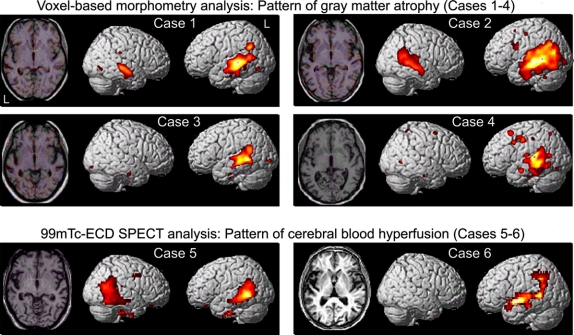Abstract
Objective:
Primary progressive aphasia (PPA) is characterized by isolated decline in language functions. Semantic dementia and progressive nonfluent aphasia are accepted PPA variants. A “logopenic” variant (LPA) has also been proposed, but its cognitive and anatomic profile is less defined. The aim of this study was to establish the cognitive and anatomic features of LPA.
Methods:
Six previously unreported LPA cases underwent extensive neuropsychological evaluation and an experimental study of phonological loop functions, including auditory and visual span tasks with digits, letters, and words. For each patient, a voxel-wise, automated analysis of MRI or SPECT data were conducted using SPM2.
Results:
In LPA, speech rate was slow, with long word-finding pauses. Grammar and articulation were preserved, although phonological paraphasias could be present. Repetition and comprehension were impaired for sentences but preserved for single words, and naming was moderately affected. Investigation of phonological loop functions showed that patients were severely impaired in digit, letter, and word span tasks. Performance did not improve with pointing, was influenced by word length, and did not show the normal phonological similarity effect. Atrophy or decreased blood flow was consistently found in the posterior portion of the left superior and middle temporal gyri and inferior parietal lobule.
Conclusions:
Logopenic progressive aphasia (LPA) is a distinctive variant of primary progressive aphasia. Cognitive and neuroimaging data indicate that a deficit in phonological loop functions may be the core mechanism underlying the LPA clinical syndrome. Recent studies suggest that Alzheimer disease may be the most common pathology underlying the LPA clinical syndrome.
GLOSSARY
- AD
= Alzheimer disease;
- BA
= Brodmann area;
- CDR
= Clinical Dementia Rating;
- CVLT-MS
= California Verbal Learning Test–Mental Status Edition;
- ECD
= ethyl cysteinate dimer;
- FWHM
= full-width at half-maximum;
- GM
= gray matter;
- LPA
= logopenic progressive aphasia;
- MMSE
= Mini-Mental State Examination;
- PNFA
= progressive nonfluent aphasia;
- PPA
= primary progressive aphasia;
- Rey-O
= Rey–Osterrieth;
- SemD
= semantic dementia;
- VBM
= voxel-based morphometry;
- WAB
= Western Aphasia Battery;
- WAIS-III
= Wechsler Adult Intelligence Scale, Third Edition.
Since Mesulam’s original description of primary progressive aphasia (PPA) in 1982,1 it has become clear that progressive isolated language disorders due to neurodegeneration are clinically heterogeneous. They are caused by patterns of localized cerebral dysfunction that do not necessarily match those affected “typically” by vascular strokes. Thus, the present-day distinction between progressive nonfluent aphasia (PNFA) and semantic dementia (SemD) may reflect an oversimplification of the clinical presentations of progressive aphasia.2 In a recent study,3 the term “logopenic”4 was revived to label PPA patients who did not show the pattern of language dysfunction typical of PNFA and SemD, respectively. Logopenic progressive aphasia (LPA) was characterized by slow speech, sentence repetition, and comprehension deficits, and relative sparing of motor speech, grammar, and single-word comprehension.3 Significant atrophy was found in the left posterior temporoparietal region, rather than in the left frontoinsular or anterior temporal areas typically affected in PNFA and SemD, respectively. In agreement with the location of atrophy, it was hypothesized that a deficit in auditory verbal short-term memory could be the core mechanism in LPA.3,5 Short-term memory is a limited-capacity system allowing the temporary storage and manipulation of information.6 Baddeley7 proposed a multicomponent model of verbal working memory comprising the central executive and the phonological loop. The phonological loop is a component of short-term memory that includes a “store,” in which phonological memory traces are held over a period of few seconds, and an articulatory “rehearsal” process that refreshes them.
Despite the initial observation,3 studies investigating the cognitive and anatomic mechanism in LPA are lacking, and even its existence is under debate. Here, we performed a detailed neuroimaging and cognitive study of six new cases of LPA, including an experimental assessment of phonological loop functions. We hypothesized that all patients would show phonological loop deficits and anatomic involvement of the left posterior temporoparietal region. Confirmation of this hypothesis would establish LPA as a recognizable, separate clinical variant of PPA with specific neuroimaging correlates.
METHODS
Subjects.
Six LPA patients (table 1) at the University of California, San Francisco Memory and Aging Center (n = 4) or at the Neurology Unit, San Raffaele Turro, Milan (n = 2), participated in the study. Patients were selected from a pool of LPA cases on the basis of their ability to participate in numerous testing sessions and the availability of a brain scan. They were all new cases, not included in our previous article.3 Patients were evaluated by a team of experienced clinicians and underwent a baseline neurologic, neuropsychological, and language evaluation. LPA was diagnosed when patients did not meet criteria for SemD and PNFA because of the presence of slow, well-articulated and grammatic speech (thus excluding PNFA) and good single-word comprehension (thus excluding SemD).3 Imaging findings were not used for diagnosis. Informed consent was obtained, and the study was approved by each local ethics committee.
Table 1 Demographic, functional, and cognitive assessment for each patient (cases 1–4 from the United States, cases 5 and 6 from Italy)
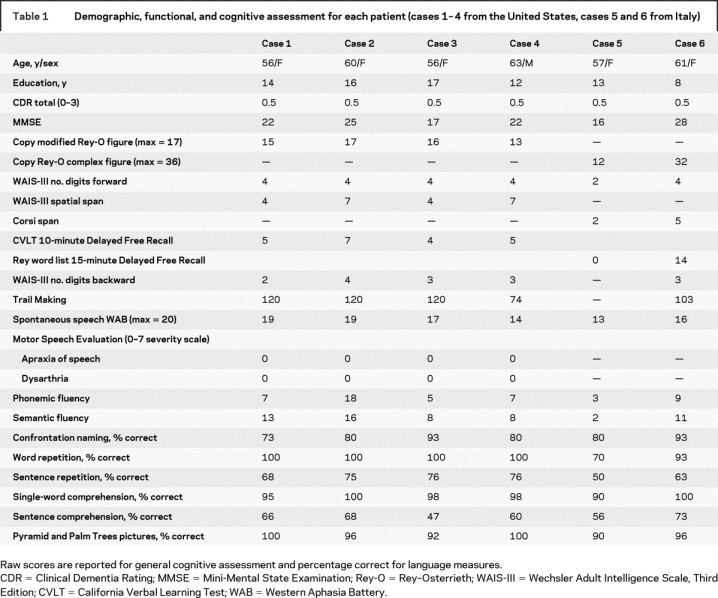
All patients had similar clinical histories with approximately 3 years of word-finding difficulties starting in their 50s. At the time of examination, three patients had mild calculation, writing, and verbal memory difficulties. None had visuospatial deficits. Anxiety, depression, and irritability were common. Two patients showed mild slowing of rapidly alternating movements in the right hand. Although extensive follow-up is still not available in most patients, clinical evolution was generally slow, with relative sparing of functional status 5 years after onset.
Cognitive assessment.
Neuropsychological assessment.
All patients underwent a comparable neuropsychological assessment, using language-specific tests of verbal long-term memory, verbal and visuospatial short-term memory, visuospatial abilities, and executive functions (table e-1 on the Neurology® Web site at www.neurology.org).
General language evaluation.
Language and cognitive functions were assessed in each patient’s native language with comparable measures. We tested fluency, single-word and sentence repetition, word–picture matching, sentence-to-picture matching, and confrontation naming using the Western Aphasia Battery,8 the Boston Naming test,9 and portions of Curtiss Yamada Comprehension Language Evaluation–Receptive10 (cases 1–4), and with the Battery for the Analysis of the Aphasic Deficit11 (cases 5 and 6). The Pyramid and Palm Trees Test pictures were used in all patients.12 In the four US patients, the Motor Speech Evaluation was also administered.13
Experimental phonological loop assessment.
The short-term memory model proposed by Baddeley7 accounts for several effects that characterize the normal functioning of the phonological loop:
The phonological similarity effect: Sequences of items that sound similar (e.g., the letters B and T) are harder to remember compared with dissimilar sounding examples (e.g., the letters W and Z). The absence of this effect indicates a phonological store deficit.
The word length effect: Sequences of long words are harder to remember than sequences of shorter words because longer words take more time to rehearse and their trace fades more quickly.
The following testing procedures were applied to all patients to test for these effects.
Digit span tasks.
Digit span tasks were administered under auditory/verbal, visual/verbal, and auditory/pointing conditions.14 For each condition, patients were presented with a sequence of digits at a rate of one digit per second and were asked to recall the exact sequence immediately after presentation. Ten trials of each sequence length (i.e., one digit, two digits, etc.) were tested. Each correctly recalled trial was scored as 0.1, so the perfect score for any given sequence length would be 1. Span level was established when the patient recalled at least six trials at a given length.
For the auditory/verbal condition, stimuli were presented auditorily, and patients responded verbally. For the visual/verbal condition, each digit was presented sequentially in black font on a white background, and patients were required to reproduce the sequence verbally. For the auditory/pointing condition, stimuli were presented auditorily, and patients responded by pointing to the correct items within an array of single digits. The pointing condition excluded an articulation disorder.
Letter span tasks: Phonological similarity effect.
Span levels for sequences of phonologically similar and dissimilar letters were tested. The same procedures as for the digit span were adopted but tested only in the auditory/verbal and visual/verbal conditions. Two sets of letters, phonologically similar (e.g., B, C, D, G, P, and T for both languages) and phonologically dissimilar (e.g., F, K, Q, R, X, W, and Z), were used in both languages as previously described.14 Ten sequences of letters, increasing in length and including letters from one set alone, were presented at a rate of one per second.
A group of 11 age- and education-matched normal controls (six Italian, five US) showed a significant effect of phonological similarity when tested with this material (mean phonologically similar: 6.00, mean phonologically dissimilar: 6.55; t test, p < 0.05).
Word span tasks: Word length effect.
The auditory/verbal and visual/verbal conditions were tested. Two sets of two- or four-syllable words, matched by frequency, were used for each language.14,15 For each set, 10 word sequences of increasing length were generated. No word was presented twice.
The same group of 11 controls showed a significant effect of word length (mean long word: 6.09, mean short word: 7.18; t test, p < 0.01).
Patients with a specific deficit in the phonological store are expected to show normal immediate recall of individual items, defective span in both auditory/verbal and visual/verbal conditions with no improvement with pointing, and absence of phonological similarity. The word length effect should be preserved, unless the rehearsal is also affected.
Neuroimaging study.
Voxel-based morphometry analysis of MRI data (cases 1–4).
T1-weighted MRI scans were acquired using a 1.5-tesla Magnetom VISION system (Siemens Inc., Iselin, NJ) as previously described for cases 1–4.3 Voxel-based morphometry (VBM) analysis was implemented in the SPM2 software package (The Wellcome Department of Imaging Neuroscience, London, UK) using standard procedures.16 Images were normalized to an age-matched template, modulated, and spatially smoothed with a 12-mm full-width at half-maximum (FWHM) isotropic gaussian kernel.
Group analyses of gray matter (GM) and white matter (WM) images were used to compare patients with a control group of 40 age- and sex-matched healthy controls. Single-subject GM analyses were used to compare each patient with controls. Age, total intracranial volume, and sex were confounding variables. In the group analysis, significance was set at p < 0.05 corrected for multiple comparisons (family-wise error corrected). Because of the risk of false negatives in single-subject and WM VBM analyses,17 we report results of these analyses at p < 0.001, uncorrected for multiple comparisons.
99mTc-ethyl cysteinate dimer SPECT analysis (cases 5 and 6).
99mTc-ethyl cysteinate dimer SPECT imaging was used to detect regional hypoperfusion in the two Italian patients compared with 15 age-matched normal controls, using previously described procedures.18
Image preprocessing (spatial normalization to a standard Montreal Neurological Institute SPECT template and 12-mm FWHM smoothing) and statistical analysis were implemented in SPM99 using standard validated procedures.19 Age and total global distribution of the tracer’s uptake were entered as confounding variables. Single-subject analyses were performed by comparing each patient with the control group, with significance set at p < 0.001 uncorrected.
RESULTS
Cognitive assessment.
Neuropsychological assessment.
Mini-Mental State Examination scores were abnormal in all patients, whereas the Clinical Dementia Rating was in the mild impairment range (0.5 in each patient) (table 1). The profile of neuropsychological and language impairment was compatible with an LPA diagnosis, as previously reported.3 Visuospatial abilities and spatial working memory span were preserved with the exception of case 5, in whom they were mildly impaired. Conversely, most tests with a verbal component, such as the verbal short- and long-term memory tests, revealed deficits. Case 6 was the exception, showing normal performance in long-term verbal memory.
Language evaluation.
Spontaneous speech production was characterized by slow, hesitant speech with word-finding pauses (see e-audio, table 2). Speech in response to a picture was characterized by decreased rate and occasional phonemic paraphasias and word-finding difficulty. Sentences were simple, but grammatically well formed and without omission of grammatic morphemes. Motor speech abilities were within normal limits, and no apraxia of speech or dysarthria was noted.
Table 2 Digit, letter (similar and dissimilar), and word (short and long) span results
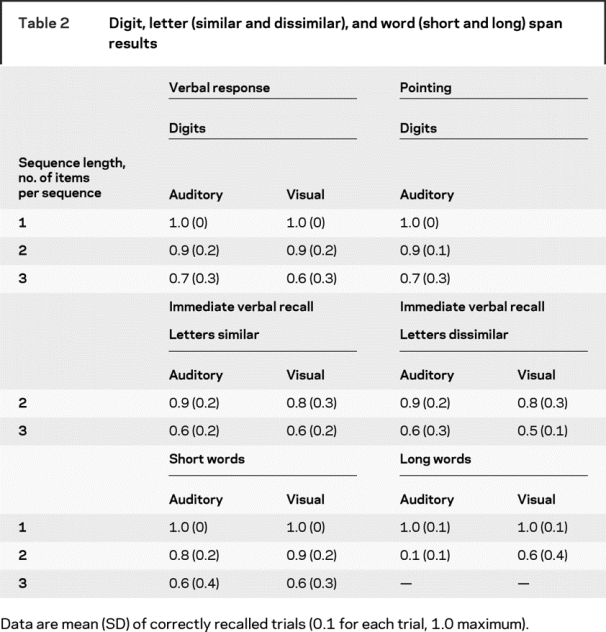
Comprehension was spared at the single-word level, and Pyramid and Palm Trees Pictures performance was mildly impaired in the two more advanced cases (cases 3 and 5), indicating that semantic memory was relatively preserved (table 1). Conversely, patients showed word-finding pauses in speech production and poor confrontation naming ability. Errors consisted mostly of complete anomia (no response) or phonemic paraphasias, suggesting a mixed mechanism of paraphasic and word-selection anomia.20 Comprehension at the sentence level was impaired, but there was no evidence of a structural complexity effect.
A specific pattern of repetition difficulties was found in all patients. Single-word repetition was largely preserved, whereas sentence repetition was severely impaired, especially for low-probability sentences. The pattern of errors in sentence repetition suggested that patients were using a semantic rather than a phonological route.21 For example, when asked to repeat “It looks as if nobody is around,” one patient responded, “It looks like nobody is there.”
Phonological loop assessment.
Digit span.
Patients performed normally on the immediate recall (repetition) of individual and pairs of digits but were severely impaired in sequences of more than three digits (table 2). Performance was unrelated to the modality of presentation (auditory or visual) or output (verbal or pointing).
Letter span: Phonological similarity effect.
Span was three in both conditions (table 2). In contrast to normal subjects, phonologically dissimilar letters provided no benefit, either with auditory or with visual presentation.
Word span: Word length effect.
Span was three for short words, but patients could repeat only one long word (table 2). This effect of word length was particularly evident in the auditory modality.
Neuroimaging study.
Analysis of gray matter atrophy or hypoperfusion.
A consistent pattern of GM atrophy (cases 1–4) or hypoperfusion (cases 5 and 6) was found in the posterior portion of the left superior and middle temporal gyri and in the inferior parietal lobule (cases 1–4 and 6) (figure 1 and table 3). In three cases, damage spread from the posterior temporal areas to the inferior and/or more anterior temporal regions. The corresponding contralateral right posterior temporal region was involved in cases 1, 2, and 5. Case 5 alone showed hypoperfusion bilaterally in the posterior cingulum.
Figure 1 Pattern of gray matter atrophy or hypoperfusion in each patient compared with healthy controls
Representative axial sections of each original structural MRI are displayed in the left panel. Voxel-based morphometry and SPECT results are thresholded at p < 0.005 uncorrected for multiple comparisons and superimposed on the three-dimensional rendering of the Montreal Neurological Institute standard brain. ECD = ethyl cysteinate dimer.
Table 3 Results of the VBM gray matter group analysis (p < 0.05 FWE corrected for multiple comparisons) and SPECT single-subject analysis (p < 0.001 uncorrected)
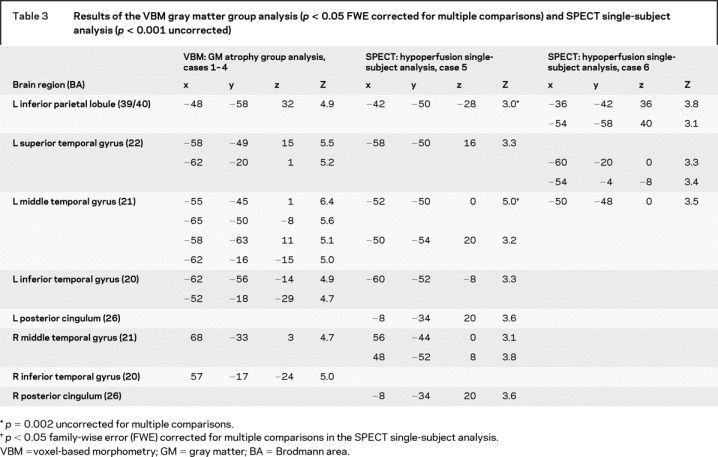
White matter atrophy.
WM loss was observed in correspondence to GM atrophy in the posterior portion of left middle temporal and bilateral posterior superior temporal gyri (figure 2).
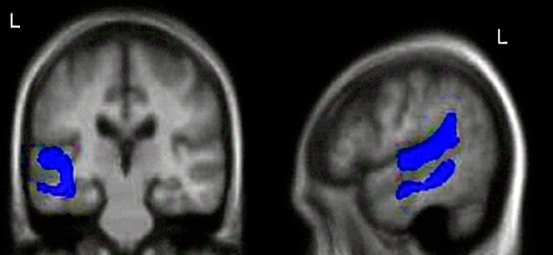
Figure 2 Pattern of white matter atrophy in the four US patients compared with controls
Voxel-based morphometry group analysis results are superimposed on the template image. Results are thresholded at p < 0.005 uncorrected for multiple comparisons. Peaks of white matter (WM) atrophy were located in the posterior portion of the left superior (most significant WM peaks: x = −53, y = −40, z = 16, Z = 4.2; x = −49, y = −21, z = −1, Z = 3.9) and middle (x = −55, y = −40, z = −9, Z = 3.8; x = −55, y = −40, z = −9, Z = 3.6) temporal gyri, and in the right posterior superior temporal gyrus (x = 56, y = −33, z = 17, Z = 3.6).
DISCUSSION
We defined the neuropsychological and imaging features of the logopenic variant of PPA that in our experience represents 30% of all PPA cases. Our results suggested that the core cognitive deficit in LPA was a phonological loop disorder. Consistently, the imaging investigation showed involvement of GM and WM in the left posterior temporal and inferior parietal regions.
LPA is characterized by a decreased rate of spontaneous language production with frequent halts due to word-finding pauses. Phonemic paraphasias are common, but motor speech and grammar are spared. This pattern of language production is different from the fast output typical of early SemD patients, who usually fill word-finding pauses with circumlocutions and filler words. It is also distinct from the production deficit typical of PNFA, in which articulation deficits and agrammatism predominate.22 LPA patients, therefore, show a pattern of “intermediate” fluency distinct from the fluent SemDs and the nonfluent PNFAs, raising the issue of how to label their language production. Fluency is a composite measure, defined by multiple features of spontaneous language production. The concept was introduced by Goodglass et al.23 to describe language production in vascular aphasia. Within this framework, a patient with would be described as “nonfluent” if he or she exhibited slow, effortful production, with motor speech impairment, defective prosody, and omission of grammatic morphemes. Conversely, fluent aphasic production would be characterized by normal motor speech and production rate, spared grammar, and the presence of phonological and lexical errors. The features of LPA patients’ spontaneous production do not easily fit within this dichotomy, because motor speech is unaffected and grammar is preserved, yet speech production is slowed and halting. LPA patients score as “fluent” on formal aphasia tests, which give more weight to articulation and grammar, but may be labeled as “nonfluent” by the clinician who is impressed by their slow and hesitant production at the bedside (see e-audio for example of spontaneous speech in case 2 two years after initial evaluation reported in table 1). We suggest that the label “nonfluent” should be reserved for patients who show the motor speech and grammar deficits typical of PNFA. The term logopenic (from the Greek: “lack of words”) could instead be used to describe the slow language output typical of LPA. Given the phonological nature of this deficit, the term phonological variant could also be applied.
The disorder of language production in LPA affects sentence repetition severely, yet spares the repetition of single words. A phonological loop disorder had been proposed to underlie this symptom.3 The performance of our patients on the experimental phonological loop battery seems to confirm this hypothesis. LPA patients have markedly reduced digit span but perform normally on single-digit repetition, indicating that their deficit cannot be attributed to defective speech perception. The abolition of the phonological similarity effect suggests that the store component of the phonological loop system is impaired.5 The articulatory rehearsal process was less affected, as evinced by the lack of improvement when the response was made by pointing, and by the partially preserved word length effect, especially in the visual modality.
The phonological loop sustains comprehension by maintaining online incoming verbal information, thus allowing syntactic interpretation of word strings.7 A capacity reduction in the system has been shown to interfere with the ability to process sentences.24 Consistently, LPA patients showed sentence comprehension deficits, regardless of syntactic complexity, whereas single-word comprehension was spared.
LPA most closely resembles vascular conduction aphasia, a syndrome characterized by fluent speech and defective repetition and comprehension of sentences.25 Cases similar to LPA have been reported by Hillis et al.26 as “progressive conduction aphasia” and also by other authors under other PPA-related labels.27,28 Conduction aphasia has been hypothesized to be caused a lesion in the arcuate fasciculus,29 although damage to posterior GM temporoparietal regions has been associated with persistent repetition disorders.30,31 Consistently, our patients with LPA showed GM and WM atrophy within the same region.
Neuroimaging results in LPA showed atrophy or hypoperfusion in left posterior middle and superior temporal and inferior parietal regions, a pattern different from SemD and PNFA. This finding confirmed, at the single-subject level, across languages and across imaging modalities, a previous group study of 10 different LPA patients.3 Both patient series showed similar location of damage, demonstrating that the LPA syndrome is associated with a typical and consistent pattern of anatomic impairment in the left posterior temporoparietal cortices. The previous association of these regions with the phonological store5,31,32 strengthens our findings of a defective functioning of this component of auditory short-term memory in LPA.
Although the term PPA refers to a clinical syndrome and not to a specific pathologic substrate, it was generally accepted that most cases would show non-Alzheimer, frontotemporal lobar degeneration–type pathology at autopsy. However, recent articles have demonstrated that focal, atypical distribution of Alzheimer disease (AD) pathology is responsible for 20% to 30% of cases with various forms of PPA.2,33–35 Retrospective PET and MRI studies36,37 demonstrated in PPA patients with AD pathology a pattern of temporoparietal involvement similar to LPA. Furthermore, all US patients described in this article had cortical amyloid binding on PET scans using the Pittsburgh compound B tracer.38 Taken together, all these findings suggest that AD could be the most frequent cause of LPA, whereas it may be less frequently responsible for the other PPA syndromes.
We have shown that LPA is a distinctive clinical variant of PPA, associated with a phonological loop disorder and with anatomic damage to the left posterior temporoparietal region. Future studies will establish whether AD is the most common pathology underlying LPA.
ACKNOWLEDGMENT
The authors thank Drs. Juliana Baldo and Serena Amici for their helpful comments.
Supplementary Material
e-Pub ahead of print on July 16, 2008, at www.neurology.org.
Supported by the National Institute of Neurological Disorders and Stroke (R01 NS050915), the State of California (DHS 04-35516), the National Institute on Aging (P50 AG03006, P01 AG019724), the Alzheimer’s Disease Research Center of California (03-75271 DHS/ADP/ARCC), and the Italian Ministry for University and Scientific Research (Interlink Grant to S.F.C. and M.L.G.-T.).
Disclosure: The authors report no disclosures.
Address correspondence and reprint requests to Dr. Maria Luisa Gorno-Tempini, UCSF Memory and Aging Center, 350 Parnassus Ave., Suite 506, San Francisco, CA 94143
marilu@memory.ucsf.edu
Supplemental data at www.neurology.org
Editorial, page 1218
Received September 26, 2007. Accepted in final form May 2, 2008.
REFERENCES
- 1.Mesulam MM. Slowly progressive aphasia without generalized dementia. Ann Neurol 1982;11:592–598. [DOI] [PubMed] [Google Scholar]
- 2.Kertesz A, Munoz DG. Primary progressive aphasia: a review of the neurobiology of a common presentation of Pick complex. Am J Alzheimers Dis Other Demen 2002;17:30–36. [DOI] [PMC free article] [PubMed] [Google Scholar]
- 3.Gorno-Tempini ML, Dronkers NF, Rankin KP, et al. Cognition and anatomy in three variants of primary progressive aphasia. Ann Neurol 2004;55:335–346. [DOI] [PMC free article] [PubMed] [Google Scholar]
- 4.Weintraub S, Rubin NP, Mesulam M-M. Primary progressive aphasia: longitudinal course, neuropsychological profile, and language features. Arch Neurol 1990;47:1329–1335. [DOI] [PubMed] [Google Scholar]
- 5.Vallar G, DiBetta AM, Silveri MC. The phonological short-term store-rehearsal system: patterns of impairment and neural correlates. Neuropsychologia 1997;35:795–812. [DOI] [PubMed] [Google Scholar]
- 6.Baddeley AD, Hitch GJ. Working memory. In: Bower G, ed. Recent Advances in Learning and Motivation. London: Academic Press, 1974:47–90. [Google Scholar]
- 7.Baddeley A. Cognitive psychology and human memory. Trends Neurosci 1988;11:176–181. [DOI] [PubMed] [Google Scholar]
- 8.Kertesz A. Western Aphasia Battery. London, Ontario, Canada: University of Western Ontario Press, 1980. [Google Scholar]
- 9.Goodglass H, Kaplan E. Boston Diagnostic Aphasia Examination (BDAE). Philadelphia: Lea & Febiger; distributed by Psychological Assessment Resources, Odessa, FL, 1983. [Google Scholar]
- 10.Curtiss S, Yamada J. Curtiss-Yamada Comprehensive Language Evaluation. Unpublished test. 1988.
- 11.Miceli G, Laudanna A, Burani C. Batteria per l’Analisi dei Deficit Afasici. Roma: Universita’ Cattolica, 1994. [Google Scholar]
- 12.Howard D, Patterson K. Pyramids and Palm Trees: A Test of Semantic Access from Pictures and Words. Suffolk: Thames Valley Test Company, 1992. [Google Scholar]
- 13.Wertz RT, LaPointe LL, Rosenbek JC. Apraxia of Speech: The Disorder and Its Management. New York: Grune and Stratton, 1984. [Google Scholar]
- 14.Vallar G, Baddeley AD. Fractionation of working memory: neuropsychological evidence for a phonological short-term store. J Verbal Learning Verbal Behav 1984;23:151–161. [Google Scholar]
- 15.Baddeley AD, Thomson N, Buchanan M. Word length and the structure of short term memory. J Verbal Learning Verbal Behav 1975;14:575–589. [Google Scholar]
- 16.Good CD, Scahill RI, Fox NC, et al. Automatic differentiation of anatomical patterns in the human brain: validation with studies of degenerative dementias. Neuroimage 2002;17:29–46. [DOI] [PubMed] [Google Scholar]
- 17.Buchel C, Raedler T, Sommer M, Sach M, Weiller C, Koch MA. White matter asymmetry in the human brain: a diffusion tensor MRI study. Cereb Cortex 2004;14:945–951. [DOI] [PubMed] [Google Scholar]
- 18.Borroni B, Anchisi D, Paghera B, et al. Combined 99mTc-ECD SPECT and neuropsychological studies in MCI for the assessment of conversion to AD. Neurobiol Aging 2006;27:24–31. [DOI] [PubMed] [Google Scholar]
- 19.Signorini M, Paulesu E, Friston K, et al. Rapid assessment of regional cerebral metabolic abnormalities in single subjects with quantitative and nonquantitative [18F]FDG PET: a clinical validation of statistical parametric mapping. Neuroimage 1999;9:63–80. [DOI] [PubMed] [Google Scholar]
- 20.Benson DF. Aphasia, Alexia and Agraphia. New York: Churchill Livingstone, 1979. [Google Scholar]
- 21.Howard D, Franklin S. Missing the Meaning? A Cognitive Neuropsychological Study of the Processing of Words by an Aphasic Patient. Cambridge: MIT Press, 1988. [Google Scholar]
- 22.Grossman M, Mickanin J, Onishi K, et al. Progressive non-fluent aphasia: language, cognitive and PET measures contrasted with probable Alzheimer’s disease. J Cogn Neurosci 1996;8:135–154. [DOI] [PubMed] [Google Scholar]
- 23.Goodglass H, Quadfasel FA, Timberlake WH. Phrase length and type and severity of aphasia. Cortex 1964;1:133–153. [Google Scholar]
- 24.Vallar G, Papagno C. Neuropsychological impairment of verbal short-term memory. In: Baddeley AD, Kopelman MD, Wilson BA. The Handbook of Memory Disorders, 2nd ed. New York: Wiley, 2002:249–270. [Google Scholar]
- 25.Caramazza A, Brendt RS, Basili AG, Koller JJ. Syntactic processing deficits in aphasia. Cortex 1981;17:333–348. [DOI] [PubMed] [Google Scholar]
- 26.Hillis AE, Selnes OA, Gordon B. Primary progressive conduction aphasia: a cognitive analysis of two cases. Brain Lang 1999;69:478–481. [Google Scholar]
- 27.Mendez MF, Clark DG, Shapira JS, Cummings JL. Speech and language in progressive nonfluent aphasia compared with early Alzheimer’s disease. Neurology 2003;61:1108–1113. [DOI] [PubMed] [Google Scholar]
- 28.Galton CJ, Patterson K, Xuereb JH, Hodges JR. Atypical and typical presentations of Alzheimer’s disease: a clinical, neuropsychological, neuroimaging and pathological study of 13 cases. Brain 2000;123(pt 3):484–498. [DOI] [PubMed] [Google Scholar]
- 29.Benson DF, Sheremata WA, Bouchard R, Segarra JM, Price D, Geschwind N. Conduction aphasia: a clinicopathological study. Arch Neurol 1973;28:339–346. [DOI] [PubMed] [Google Scholar]
- 30.Selnes OA, Knopman DS, Niccum N, Rubens AB. The critical role of Wernicke’s area in sentence repetition. Ann Neurol 1985;17:549–557. [DOI] [PubMed] [Google Scholar]
- 31.Baldo JV, Dronkers NF. The role of inferior parietal and inferior frontal cortex in working memory. Neuropsychology 2006;20:529–538. [DOI] [PubMed] [Google Scholar]
- 32.Paulesu E, Frith CD, Frackowiak RS. The neural correlates of the verbal component of working memory. Nature 1993;362:342–345. [DOI] [PubMed] [Google Scholar]
- 33.Knibb JA, Xuereb JH, Patterson K, Hodges JR. Clinical and pathological characterization of progressive aphasia. Ann Neurol 2006;59:156–165. [DOI] [PubMed] [Google Scholar]
- 34.Davies RR, Hodges JR, Kril JJ, Patterson K, Halliday GM, Xuereb JH. The pathological basis of semantic dementia. Brain 2005;128(pt 9):1984–1995. [DOI] [PubMed] [Google Scholar]
- 35.Alladi S, Xuereb J, Bak T, et al. Focal cortical presentations of Alzheimer’s disease. Brain 2007;130(pt 10):2636–2645. [DOI] [PubMed] [Google Scholar]
- 36.Nestor PJ, Balan K, Cheow HK, et al. Nuclear imaging can predict pathologic diagnosis in progressive nonfluent aphasia. Neurology 2007;68:238–239. [DOI] [PubMed] [Google Scholar]
- 37.Josephs KA, Whitwell JL, Duffy JR, et al. Progressive aphasia secondary to Alzheimer disease vs FTLD pathology. Neurology 2008;70:25–34. [DOI] [PMC free article] [PubMed] [Google Scholar]
- 38.Rabinovici G, Furst A, Miller BL, Jagust WJ, Gorno-Tempini ML. [11C] PIB PET in three variants of primary progressive aphasia. Neurology 2007;68 (suppl 1):A60. [Google Scholar]
Associated Data
This section collects any data citations, data availability statements, or supplementary materials included in this article.



